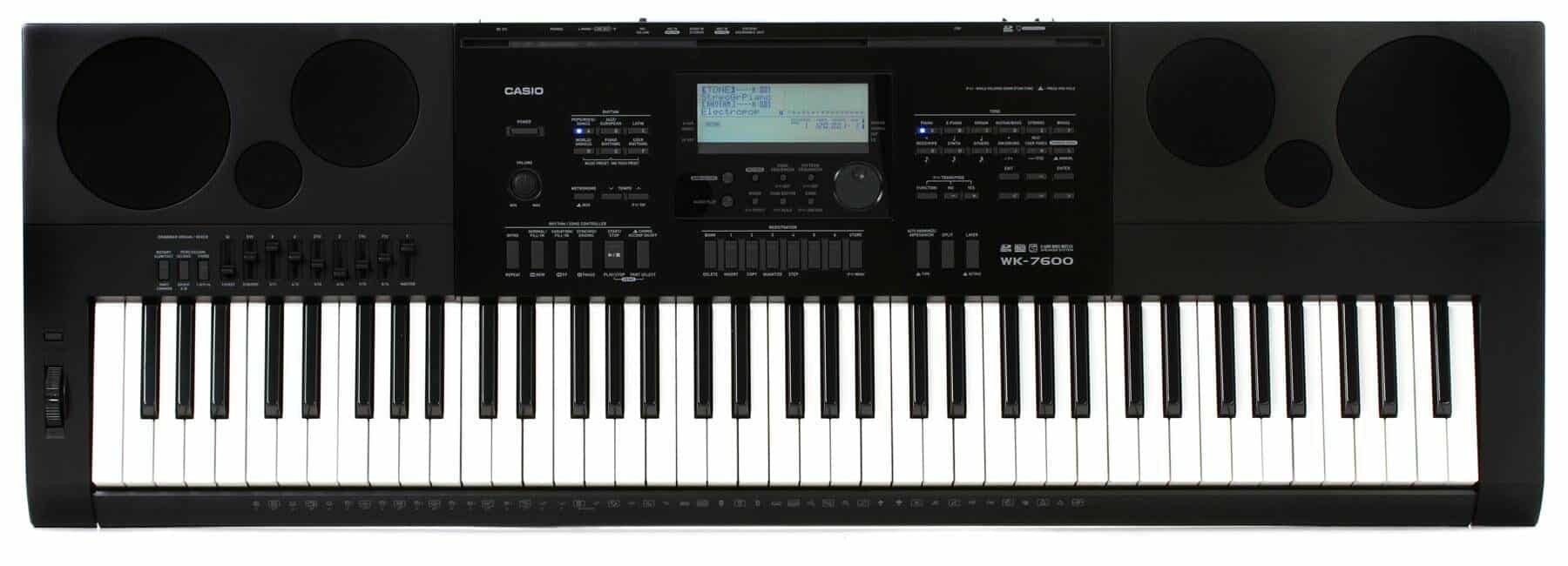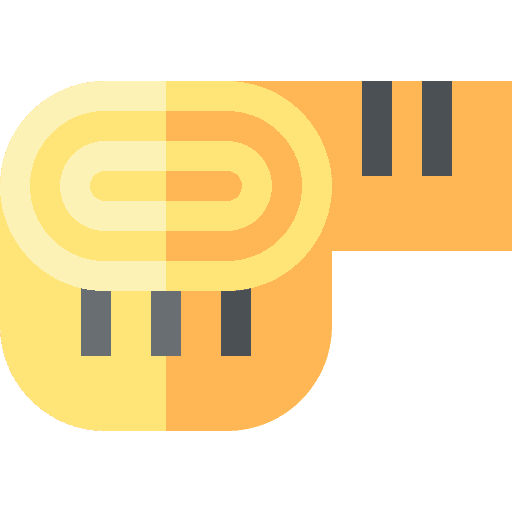There are lots of different varieties of piano out there; digital pianos, acoustic pianos, keyboards. They all differ in many ways, one of which is the amount of keys they have. Generally, acoustic pianos have a full 88 key keyboard. However, there are a smaller subset of digital pianos that are excellent for teaching, learning and gigging with only 76 keys. In this article we're going to go through some of the best 76 key digital pianos and keyboards.
First off, let's get straight to the point; let's go through the list. Then we'll go through some of the benefits of buying a 76 key model over something larger.
Our #1 Choice: Yamaha NP-32 Piaggero Digital Piano

Specification List
Good for
Not so good for
A good quality product at a very reasonable price. If you're wanting bells and whistles, however, you'll be disappointed.
Our Rating:
Features; what's good about the Yamaha NP-32
Touch sensitivity
Yamaha’s Graded Soft Touch is amazing here. The lower keys are heavier, and the higher keys are lighter, just as they are on a real piano. The result of this is that you get a really good sense of what it’s like to play a real acoustic piano, while still retaining the slightly softer touch of a digital keyboard. The keys feel fantastic to play too - very comfortable under the fingers for those long practice sessions.
Sound
You won’t necessarily be buying this for its’ features, and the number of sounds are pretty sparse. However, the sounds that are included are amazing. You get a great selection of high quality sounds of acoustic pianos, electric pianos, organs, harpsichords, vibraphones and strings. The overall quality of the sound is great - the grand piano sound particularly stands out though. Recorded from a real Yamaha CFX concert grand piano, this thing is just a joy to play.
Weight
At 5.7kg, this is not heavy at all, and you won’t struggle to move it from place to place. However, there are lighter models on the market. This piano seems like a perfectly reasonable weight given the build quality and the features that you get.
Recording
Recording is a must for practice. I say this to my students time and again - it’s not vain to record yourself to see how you sound. You can’t adequately judge how you sound when you’re actually playing, and the only way to improve is to record yourself and critique. The NP-32 will allow you to do exactly that.

What's not so good about the Yamaha NP-32
Keys
While the touch sensitivity is great, the keys aren’t actually weighted. So unfortunately, you won’t get the “real piano” experience with this model. If you’re used to something bigger, you may find the keys too light and spongy. However, it’s perfect for a beginner pianist, aspiring to train their fingers before they graduate to a larger piano.
Features
While I understand this is supposed to be a serious practice instrument and not a toy, I can’t help but feel that at this price point we should have more than 10 voices. The features on this piano are incredibly sparse - I suppose, however, this could be a good thing if you require focused, concentrated practice, without getting distracted by the bells and whistles of a fancier keyboard.
Our #2 Choice: Casio WK-7600 Piano Portable Keyboard

Specification List
Good for
Not so good for
Interesting keyboard, with a lot of features. However, I don't consider this a serious instrument, and it's probably not suitable for a serious learner.
Our Rating:
Features; what's good about the Casio WK-7600
Voices
This piano is packed with hundreds and hundreds of different voices. You could spend hours trying them all out, but if you’re a session musician or you play keyboards for a living you will thoroughly appreciate this. You’ll never run out of different sounds to try!
Features
Coupled with the huge number of voices, this keyboard includes a range of other features that you just won’t see on the other models mentioned here. You get a pitch bend wheel, rotary and percussion effects, accompaniment features and rhythm (very useful for someone learning to play keyboards) and rhythm editing and sampling features. You potentially have a whole orchestra or band at your fingertips with this Casio.
Screen + Controls
I love the screen on this model. The previous Yamaha we mentioned requires on a series of complicated key presses to get the voices you want, but this Casio makes it so easy to see which voice and rhythm style you’ve selected, and when you want to change it, you have visual confirmation. The screen itself is a light blue tinge - it’s lovely, clear and bright, but not distracting when you’re actually playing.

What's not so good about the Casio WK-7600
Piano voice
The piano voice on this model isn’t a patch on the Yamaha. I don’t know where they’ve got this one, but to my trained ear it just sounds like a toy piano. It’s an extremely bright sound, and is probably virtually modelled rather than sampled. It actually began to get on my nerves after a while. However, if you’re not too bothered about the piano sound and want something with a huge variety of different sounds and tones, this probably won’t concern you too much.
Keys
Unlike the Yamaha, the keys on this Casio are just not too pleasurable to play. They feel plasticy and spongy, and after playing this piano for around half an hour I got bored and went to play my real piano. While this probably wouldn’t bother a beginner, the Casio became more and more unpleasant to play as I continued trialling it, and to be honest this alone would put me off buying one or recommending it.
Our #3 Choice: Yamaha PSREW300 Portable Electronic Keyboard

Specification List
Good for
Not so good for
Interesting keyboard, with a lot of features. However, I don't consider this a serious instrument, and it's probably not suitable for a serious learner.
Our Rating:
Features; what's good about the Yamaha PSREW300
Learning functionality
Playing around with this keyboard was really cool. Yamaha have included what they call the “keys to success” programme, which offers short, step-by-step lessons that teach you to play the built-in songs. It’s absolutely no substitute for a proper teacher, but it can definitely help if you’re interested in learning any of the built-in music.
Duo mode
While I’ve said this piano is not so good for teaching, there is one feature that really stands out - duo mode. What this does is split the piano into two, which allows two people to play on the same instrument by creating two middle-C notes. This can be really helpful for demonstrating to a student or practising along with them.
Features
This thing is packed with features. You get a pitch bend wheel, real band backing tracks, over 570 separate voices, the ability to adjust the sound with a master EQ and digital effects such as reverb and even environment effects which allow you to sound like you’re playing in a concert hall or a cathedral. You really won’t get bored with the features of this instrument - you could be experimenting all day.

What's not so good about the Yamaha PSREW300
Keys/Touch sensitivity
Unfortunately, when testing this piano, I found that the keys weren’t particularly nice to play. It seems that Yamaha has in some way neglected the playing experience, and has focussed on all the other things. The result is a spongy, extremely light keyboard, that is probably fine for some people, but if I was using this to try to develop finger strength and tone production, I would be very disappointed.
Bells and whistles
While this piano is feature-packed, it does detract from the experience somewhat. There are so many possibilities, so many things going on that it’s easy to get distracted. If a student of yours bought this they might be so overwhelmed with the features that instead of practicing, they just kept playing with all the drum sounds and backing tracks! Not a great buy for a serious piano student.
Sustain pedal
Shockingly, I found no way of connecting a sustain pedal to this keyboard. This is an absolute must for anyone progressing beyond around grade 5 standard, and as a result if you’re learning the piano, you will outgrow this instrument pretty quickly. It’s not possible to play difficult piano music without a sustain pedal, unless you just play Bach, so if you envision yourself progressing through the grades anytime soon, you might want to overlook this model and go for a different one.
Our #4 Choice: Yamaha P121 Digital Piano

Specification List
Good for
Not so good for
A serious instrument for serious pianists. If you're looking for an alternative to an upright piano, or are looking to upgrade from a non-weighted keyboard, this is a great choice. However, you'll very likely be limited by the included 73 keys, so you should only pick this if you absolutely know you won't need a full 88 keys.
Our Rating:
Features; what's good about the Yamaha P121
Keys and touch sensitivity
The keys on this are as good as any other Yamaha digital piano. They are well-weighted, and feel pleasant under the hand. You won’t go far wrong with this keyboard, even if you’re playing extremely complex classical music. This is also the only properly weighted keyboard that I could find in the 73 - 76 key range.
Features
While this piano is geared towards a more serious audience, it offers a good compromise on features. You get 24 voices, as well as two track recording. This should be enough for most students and teachers, without the added distractions of hundreds of different voices, backing tracks, rhythms, etc.
Sounds
The sounds on this piano are exceptional. I didn’t pay too much attention to the extra voices, focusing on the piano sound, but Yamaha have done a fantastic job of capturing the spirit of their concert grand piano in this compact and affordable alternative. I didn’t want to stop playing - it sounds better than my upright!

What's not so good about the Yamaha P121
Weight
This thing weighs 14kg boxed. I don’t know what it’s like unboxed, as I haven’t weighed it, but it isn’t light. If you’re lugging this around from gig to gig, you’re going to give yourself back problems. Absolutely if you want portability, you need something lighter.
73 keys
Why has Yamaha only included 73 keys? A cost cutting measure? I really don’t see the point of this, those extra three keys bring it to the same standard as all the other pianos here and make it that much more accessible and relevant to the musician wanting as close to a full piano experience as possible. I can’t see the logic of including only 73 keys, as it’s just limiting.
Price
Compared to the others - this is expensive. At least several hundred dollars, depending on where you buy. If you’re ready for that kind of outlay, you’re probably better going for something like the P-125, which is a similar price but has a full 88 note keyboard which won’t limit you to what you can play. Unless there’s a specific reason why you want 73 keys, the P-125 is the better option.
Some more information; why 76 keys?
76 key digital pianos offer a number of advantages over more portable models. For a start, you have fewer keys - fewer keys means less weight, and this makes it much easier for you to take your piano with you when you go gigging or if you give lessons to students at their homes. An 88 key piano can be very heavy, and a 76 key piano is going to offer you much of the full size piano experience, without the added weight.
In addition to this, you might have decided that you want a piano but don’t want it to take up much space in your home. The 76 key size is perfect for this - again, enough to give you the full-size piano experience, but compact and lightweight enough to be put away in a closet when not in use, or simply stored in the corner of a room until it’s time to practice again.
These models are often marketed at professionals, so you can be sure you’re getting a quality product that is feature-packed, without the huge price tag associated with some full-size digital pianos. This is usually the size I recommend my students buy when they’re first starting out - it’s a good enough instrument for you to discover whether you’re committed to the piano without a huge outlay.
Advantages over a full-size piano
Advantages over a full-size piano are numerous, but here are a few of the main ones.

Space
The 76 key models are very compact - can be stored under a bed or in a closet when not in use.

Cost
You’ll pick up a 76 key model for around $250 - $350, whereas you would have to spend at least around $400 for a full size digital piano. This represents a very attractive cost savings if you’re on a budget, or just starting out and not sure you’ll commit.

Weight
If you’re a gig musician, you will love the fact that you can take your 76 key piano with you to gigs, without the bulk of a full size 88 key piano. 76 keys is enough to play 99% of pop, jazz and rock music, so you won’t find yourself shortchanged by the missing octave.
Disadvantages over a full size piano
However, despite the benefits of buying a 76 key piano, there are a few drawbacks. You’ll have to decide whether any of these are a deal breaker for you.

Lack of a full size keyboard
This probably goes without saying, but if you’re an aspiring classical concert pianist, the 76 key models are not for you. If you require a keyboard with 88 keys, because you’re playing music that spans the full length of the keyboard, you’ll need to purchase an 88 key model. Otherwise, you’re going to be dissatisfied.

(Sometimes) lack of proper weighted keys
Because these are more keyboards than pianos, often 76 key pianos lack fully weighted keys, instead opting for touch sensitive keys. Touch sensitivity is great, and it mimics the action of a real piano fairly well, but if you’re going to be transitioning to a real piano soon, or your teacher has a real piano, it would be worth looking only at the models with real weighted keys, like the Yamaha P-121.
So, what’s the verdict?
The best 76 weighted key digital piano on the market today is the Yamaha NP32 Piaggero Digital Piano. It’s extremely reasonably priced, and will serve beginner and professional alike admirably. I’ve never owned one of these, but I’ve tried them in stores a few times, and was extremely impressed by the build quality and the effectiveness of the touch sensitivity. If you’re in the market for a 76 key piano, this is the one to go for.
The Best 76 Key Weighted Digital Keyboard
- Yamaha NP32 Piaggiero Digital Piano
- Casio WK-7600 Piano Portable Keyboard
- Yamaha PSREW300 Portable Electronic Keyboard
- Yamaha Digital Piano P121
I was so tempted to recommend the P121, as it’s the only properly weighted keyboard here, but I just can’t recommend it over the P-125. They’re in a similar price range but the P-125 has a full 88 note keyboard that you’ll never outgrow. I can’t recommend the P-121 over the P-125, unless there is a highly specific reason you need 73 keys rather than 88.

Please don’t headline a review as ‘Weighted Keyboards’ and then review compromise designs.
Reviews are very subjective and your obvious dislike of shorter keyboards maybe needs more consideration. I find 88 versions are so big / heavy and the top notes aren’t that useful. Give me 75 / 76 notes any day. Fits on stage so much easier, and in the back of the car.
The review is excellent. He wrote based on his experience and has given us advice on what to choose. The choice is still ours. He’s not enforcing the larger pianos on anyone. You prefer the other ones, that’s okay. That’s why they’re all in the market. Pick for yourself.